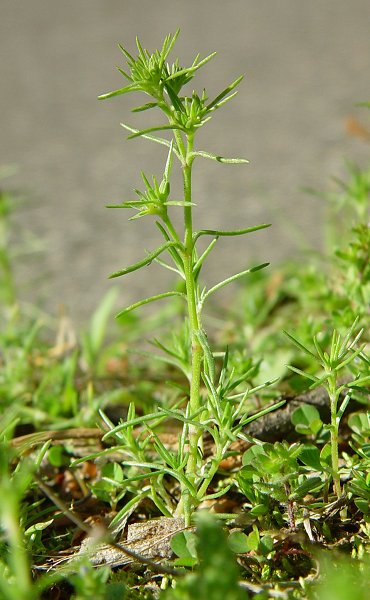Scleranthus annuus L.
Knawel

Introduced
CC = *
CW = 3
MOC = 18
© DETenaglia
Scleranthus annuus L.Knawel | |
 |
Introduced CC = * CW = 3 MOC = 18 |
© DETenaglia |
|
Family - Caryophyllaceae Habit - Taprooted annual or biennial forb. Stems - Spreading to erect, to 25 cm long, usually many-branched, glabrous or moderately to densely pubescent with minute, stalked glands, often mostly on one side of the stem.
Leaves - Opposite, decussate, sessile, linear to subulate, entire, fused basally into a small sheath, lacking axillary clusters of leaves. Leaf blades 0.3-2.4 cm long, narrowly triangular to more commonly linear, not fleshy, slightly expanded to more or less tapered at the base, angled or tapered to a bluntly or more commonly sharply pointed tip. Inflorescence - Open to dense terminal and axillary bracteate cymes, sometimes also with solitary axillary flowers, sessile or appearing with minute, tapered stalks, the bracts paired and leaflike.
Flowers - Petals absent. Sepals 5, free, 1.5-4.0 mm long, attached along the upper margin of the hypanthium, green with lighter margins, lanceolate to awl-shaped, angled to a usually sharply pointed tip, leathery, usually somewhat concave but not hooded or awned, the margins often somewhat inrolled, thin and white, glabrous. Hypanthium 1.2-2.0 mm long, thick-walled, hardened, and enclosing the ovary, deeply cup-shaped to somewhat urn-shaped with an incurved, white rim along the upper margin, persistent and becoming strongly 10-ribbed at fruiting. Stamens 2-10, the filaments distinct, attached along the inner rim of the calyx tube. Staminodes absent or 5-8, linear or narrowly triangular. Pistil with 1 locule, the ovary minutely stalked. Styles 2, each with a capitate terminal stigmatic area.
Fruits - Achenelike, dehiscing irregularly with age, 3.2-5.0 mm long, enclosed in and shed with the persistent hypanthium and sepals. Seed 1, 0.8-1.0 mm wide, more or less spherical, the surface smooth, yellowish brown, lacking wings or appendages. Flowering - March - October. Habitat - Sandstone glades, streambanks, pastures, cemeteries, lawns, roadsides, and open, disturbed areas, often in sandy substrate. Origin - Native to Europe. Lookalikes - None. Other info. - This little species is easily overlooked in the field because of its small size and inconspicuous green flowers. Once spotted it is relatively easily identified on the basis of its needlelike leaves and characteristic flowers and fruits. It occurs in widely scattered locations in Missouri, mostly in the southern third of the state. The plant was first collected in Missouri by Steyermark, in 1958, and has been spreading since then. The image below shows the appearance of a more mature specimen.
The plant can form large populations in areas of poor or sandy soil. Photographs taken in Brown Summit, NC., 4-13-03 and off Hwy 22 near Carthage, NC., 4-26-03 (DETenaglia); also in Kalamazoo, Kalamazoo County, MI, 7-3-2009, and Miner, Scott County, MO, 5-21-2014 (SRTurner). |